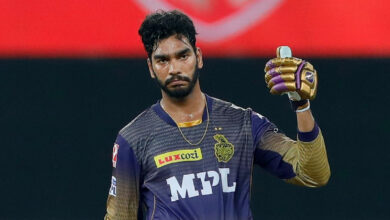T20 World Cup: How catching a 15 kg tigerfish helped Quinton de Kock’s comeback | Cricket News

All hell had broken loose after Quinton de Kock didn’t follow his team mates in taking the knee at the 2021 T20 World Cup in UAE. Given the country’s apartheid past, South Africa was outraged. A sporting icon’s refusal to be part of the team’s symbolic gesture against racism was not acceptable for the majority in the country. Even his ‘cricketing father’ was disappointed.Geoffrey Toyana, a black African, felt hurt the boy he had coached since his U19 days, and known even longer. But the coach quickly rushed to de Kock’s defence. “I’ve known Quinton since he was 15. His family, he’s got a black brother and sers as well. I think it’s about trying to understand one another and minding each other. We all come from different years of life, with different challenges,” Toyana tells The Indian Express, mulling how Cricket South Africa (CSA) could’ve done things differently.
It was a dark phase for de Kock. Even before he started playing for the Proteas, de Kock was known for his fey character, prone to get into on-field brawls. But this was worse, especially on the back of the CSA hearings that had shaken the country’s belief in its icons. It’s taken some time but the wounds have healed, and in 2024, de Kock has been a guiding light to South Africa’s best-ever T20 World Cup campaign. Their leading run scorer, whose demolition jobs as an opener have ignited the belief that maybe this time, at long last, South Africa can touch that silverware.
“With Quinny, it’s not just his batting. He’s the keeper as well as one of the leaders of the side. He adds up a lot,” Toyana believes. For him and everyone who saw de Kock play as a schoolboy cricketer, the latter was destined for these highs long ago. Pretty much since the day he decided to ditch high school for the sport.
Graduating from cricket
There’s a famous dressing joke that’s thrown around whenever de Kock’s decision to drop out of high school comes is called out. “I might not have graduated from high school but I have a master’s degree in cricket,” he had told The Cricket Monthly a few years back.
Toyana laughs upon hearing the same but agrees to the expression, “100 percent. He spends so much time on his cricket. Running, batting, keeping, for hours and hours. For me, he has done exactly what he’s wanted to do with his life.”
In a nation that was still noshing on the brilliance of Jacques Kallis, Graeme Smith, Hashim Amla, and AB de Villiers, the hype around a debutant de Kock had been unreal. At 20, his name was being put beside Adam Gilchr’s.
The coach who witnessed him decimate bowling attacks all the same while quickly transitioning from school cricket to domestic circuit to U19 to an international debut in 2012, recalls it.
“I met him in 2006. When he was still in school. Going up the ranks in school cricket, everybody talked about him. When he was 16, he was scoring hundreds every game,” Toyana says. “Since he was a schoolboy cricketer, he was a prodigy. You knew from watching him that Quinny will play for South Africa.” It wasn’t long before being naturally good at cricket wasn’t sufficient. Tough questions were asked and the cricket graduate was ready to dig deep for the answers.
Quick at fishing for answers
Toyana talks about de Kock’s first overseas tour. The Sri Lankan off-spinners, led the enigmatic Ajantha Mendis, had given him a hard time. For four consecutive games, the southpaw was dismissed an offie, and found himself in a stranglehold once the tour ended. “So he came back home and then we called in all the off-spinners in our region for him to play in the nets. For months and months, all he faced was off spin.”
Then there was the 2015 ODI World Cup, where he averaged 20 from eight outings. Known for his relative ease while countering the pacers, de Kock struggled on pace conducive wickets down under. His comeback course involved fishing for answers, literally. He turned to reeling in 15Kg Tigerfish in Africa’s fourth-longest river. “Facing a Mitchell Johnson bouncer is tame comparison. Pulling in one of those monsters is the greatest adrenaline rush you can experience,” he’d explain his philosophy behind it.
“That’s a mark of a very very good player,” says Toyana. “You will have setbacks. You will have tough times. Quinton has been very good at identifying his shortcomings pretty quickly, and finding his way out of them. He is a quick learner, and grasps onto those learnings for life.”
Nothing at this World Cup demonstrates it better than his reading of the Barbados air and soil to aid his batting.
All it took were seven CPL games – only three of them at the Darren Sammy Stadium, where he scored his 65 off 38 against England in Super-8. De Kock knew a par score – which had been enough to see the batting first team through at night – wasn’t going to cut it against England in a day game.
“I don’t know if the rest of the guys knew, but I had a fair sense: I’ve played here quite a bit in the Caribbean league and it’s the same thing: the wicket looks beautiful. At night, it plays most differently but in the day, 160-170 are winning scores here in the day. I think the lights and maybe a bit of dew at night help the ball skid on a bit better,” de Kock boasted afterwards.
“Wind’s definitely a big factor, especially opening the batting when you’ve only got two guys out. You’ve got to use that wind as much as you can: don’t fight it, just try and use it,” he added on his early onslaught against Jofra Archer, almost sounding like a wind engineer.
Toyana sums it, “He used to struggle in his school. But in cricket, he’s a master.”







